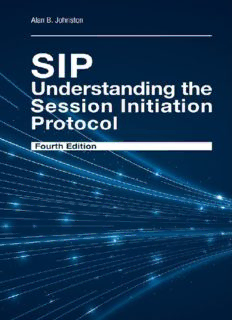
SIP: Understanding the Session Initiation Protocol PDF
Preview SIP: Understanding the Session Initiation Protocol
SIP Understanding the Session Initiation Protocol Fourth Edition For a complete listing of titles in the Artech House Telecommunications Library, turn to the back of this book. SIP Understanding the Session Initiation Protocol Fourth Edition Alan B. Johnston Library of Congress Cataloging-in-Publication Data A catalog record for this book is available from the U.S. Library of Congress. British Library Cataloguing in Publication Data A catalogue record for this book is available from the British Library. Cover design by John Gomes ISBN 13: 978-1-60807-863-9 © 2016 ARTECH HOUSE 685 Canton Street Norwood, MA 02062 All rights reserved. Printed and bound in the United States of America. No part of this book may be reproduced or utilized in any form or by any means, electronic or mechanical, including photocopying, recording, or by any information storage and retrieval system, without permission in writing from the publisher. All terms mentioned in this book that are known to be trademarks or service marks have been appropriately capitalized. Artech House cannot attest to the accuracy of this information. Use of a term in this book should not be regarded as affecting the validity of any trademark or service mark. 10 9 8 7 6 5 4 3 2 1 Contents Preface to the Fourth Edition Acknowledgment 1 SIP and the Internet 1.1 Signaling Protocols 1.2 Internet Multimedia Protocol Stack 1.2.1 Physical Layer 1.2.2 Data/Link Layer 1.2.3 Network Layer 1.2.4 Transport Layer 1.2.5 Application Layer 1.2.6 Utility Applications 1.2.7 Multicast 1.3 Internet Names 1.4 URLs, URIs, and URNs 1.5 Domain Name Service 1.5.1 DNS Resource Records 1.5.2 Address Resource Records (A or AAAA) 1.5.3 Service Resource Records (SRV) 1.5.4 Naming Authority Pointer Resource Records (NAPTR) 1.5.5 DNS Resolvers 1.6 Global Open Standards 1.7 Internet Standards Process 1.8 A Brief History of SIP 1.9 Conclusion References 2 Introduction to SIP 2.1 A Simple Session Establishment Example 2.2 SIP Call with a Proxy Server 2.3 SIP Registration Example 2.4 SIP Presence and Instant Message Example 2.5 Message Transport 2.5.1 UDP Transport 2.5.2 TCP Transport 2.5.3 TLS Transport 2.5.4 SCTP Transport 2.6 Transport Protocol Selection 2.7 Conclusion 2.8 Questions References 3 SIP Clients and Servers 3.1 SIP User Agents 3.2 Presence Agents 3.3 Back-to-Back User Agents 3.4 SIP Gateways 3.5 SIP Servers 3.5.1 Proxy Servers 3.5.2 Redirect Servers 3.5.3 Registrar Servers 3.6 Uniform Resource Indicators 3.7 Acknowledgment of Messages 3.8 Reliability 3.9 Multicast Support 3.10 Conclusion 3.11 Questions References 4 SIP Request Messages 4.1 Methods 4.1.1 INVITE 4.1.2 REGISTER 4.1.3 BYE 4.1.4 ACK 4.1.5 CANCEL 4.1.6 OPTIONS 4.1.7 SUBSCRIBE 4.1.8 NOTIFY 4.1.9 PUBLISH 4.1.10 REFER 4.1.11 MESSAGE 4.1.12 INFO 4.1.13 PRACK 4.1.14 UPDATE 4.2 URI and URL Schemes Used by SIP 4.2.1 SIP and SIPS URIs 4.2.2 Telephone URLs 4.2.3 Presence and Instant Messaging URLs 4.3 Tags 4.4 Message Bodies 4.5 Conclusion 4.6 Questions References 5 SIP Response Messages 5.1 Informational 5.1.1 100 Trying 5.1.2 180 Ringing 5.1.3 181 Call is Being Forwarded 5.1.4 182 Call Queued 5.1.5 183 Session Progress 5.1.6 199 Early Dialog Terminated 5.2 Success 5.2.1 200 OK 5.2.2 202 Accepted 5.2.3 204 No Notification 5.3 Redirection 5.3.1 300 Multiple Choices 5.3.2 301 Moved Permanently 5.3.3 302 Moved Temporarily 5.3.4 305 Use Proxy 5.3.5 380 Alternative Service 5.4 Client Error 5.4.1 400 Bad Request 5.4.2 401 Unauthorized 5.4.3 402 Payment Required 5.4.4 403 Forbidden 5.4.5 404 Not Found 5.4.6 405 Method Not Allowed 5.4.7 406 Not Acceptable 5.4.8 407 Proxy Authentication Required 5.4.9 408 Request Timeout 5.4.10 409 Conflict 5.4.11 410 Gone 5.4.12 411 Length Required 5.4.13 412 Conditional Request Failed 5.4.14 413 Request Entity Too Large 5.4.15 414 Request-URI Too Long 5.4.16 415 Unsupported Media Type 5.4.17 416 Unsupported URI Scheme 5.4.18 417 Unknown Resource Priority 5.4.19 420 Bad Extension 5.4.20 421 Extension Required 5.4.21 422 Session Timer Interval Too Small 5.4.22 423 Interval Too Brief 5.4.23 424 Bad Location Information 5.4.24 428 Use Identity Header 5.4.25 429 Provide Referror Identity 5.4.26 430 Flow Failed 5.4.27 433 Anonymity Disallowed 5.4.28 436 Bad Identity-Info Header 5.4.29 437 Unsupported Certificate 5.4.30 438 Invalid Identity Header 5.4.31 439 First Hop Lacks Outbound Support 5.4.32 440 Max Breadth Exceeded 469 Bad Info Package 5.4.33 5.4.34 494 Security Agreement Required 5.4.35 470 Consent Needed 5.4.36 480 Temporarily Unavailable 5.4.37 481 Dialog/Transaction Does Not Exist 5.4.38 482 Loop Detected 5.4.39 483 Too Many Hops 5.4.40 484 Address Incomplete 5.4.41 485 Ambiguous 5.4.42 486 Busy Here 5.4.43 487 Request Terminated 5.4.44 488 Not Acceptable Here 5.4.45 489 Bad Event 5.4.46 491 Request Pending 5.4.47 493 Request Undecipherable 5.4.48 494 Security Agreement Required 5.5 Server Error 5.5.1 500 Server Internal Error 5.5.2 501 Not Implemented 5.5.3 502 Bad Gateway 5.5.4 503 Service Unavailable 5.5.5 504 Gateway Timeout 5.5.6 505 Version Not Supported 5.5.7 513 Message Too Large 5.5.8 580 Preconditions Failure 5.6 Global Error 5.6.1 600 Busy Everywhere 5.6.2 603 Decline 5.6.3 604 Does Not Exist Anywhere 5.6.4 606 Not Acceptable 5.7 Questions References 6 SIP Header Fields 6.1 Request and Response Header Fields 6.1.1 Accept 6.1.2 Accept-Encoding
Description: